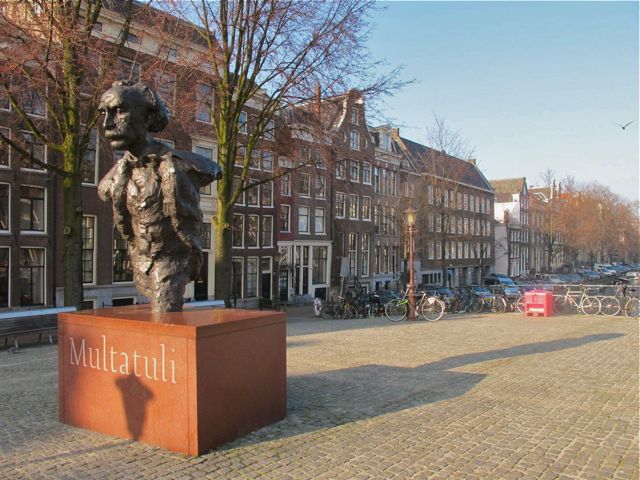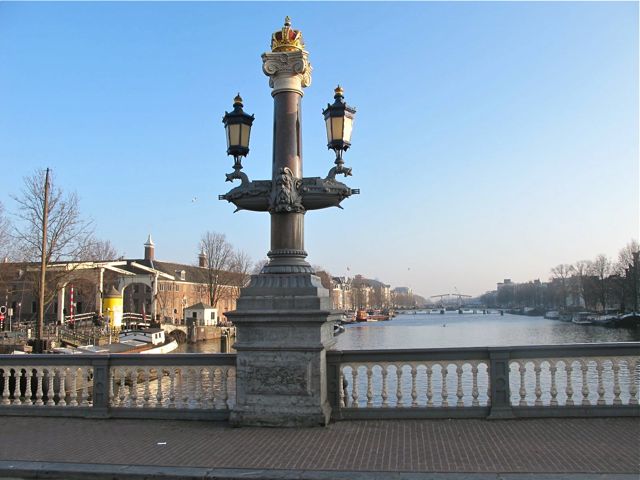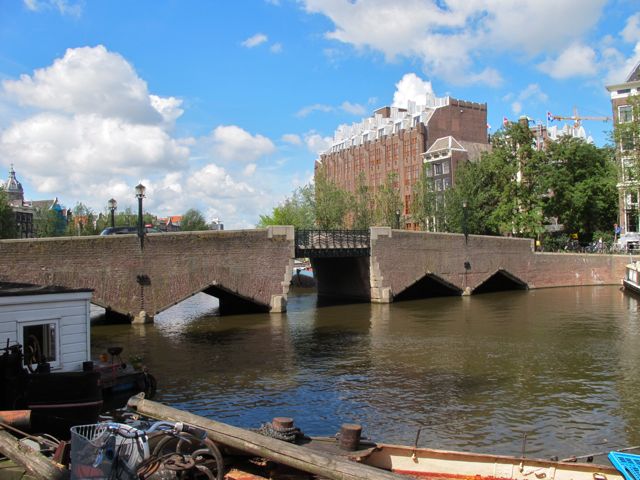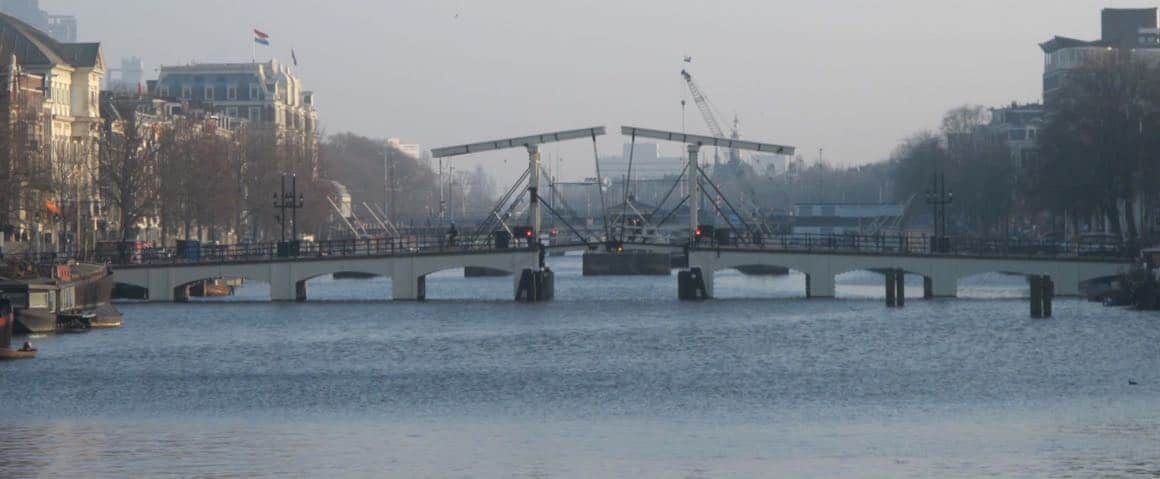Amsterdam is the city of canals (gracht in Dutch) and the city of bridges (brug in Dutch). From old bridges to modern bridges in Amsterdam, here are 10 facts about Amsterdam bridges.
1. Venice is the Amsterdam of the South
Amsterdam has the largest number of bridges in the world! Amsterdam counts some 2500 bridges. In the city center, there are around 500 bridges, more than any other city in the world. Venice in Italy is considered the ‘City of the Canals’ or ‘City of the Bridges’ and
Amsterdam is sometimes called the Venice of the North. But Venice has only 400 bridges! So, actually, Venice should be called the Amsterdam of the South.
2. Amsterdam Tower Bridge has no tower

The Amsterdam Tower Bridge (Torensluisbrug) is famous because it’s extremely wide. The bridge spans the Singel canal.
The Singel canal dates back to the 15th century. In those days, the bridge was one of the main entrances into the medieval town of Amsterdam. A large wooden tower called Jan Roodenpoort stood on the bridge and, guards on the watch for possible hostile visitors. The cellars below were used as prison cells, that flooded during high tide!
In the 17th century, the tower and bridge received a stone coat. In the 19th century, the tower was demolished. The broad bridge is now used for terraces in summer. Lines of where the tower used to stand have been made visible in the road.
In more recent years, the spaces beneath the old tower bridge have been dug out and renovated. The spaces are now used for exhibitions, documentaries, debates, concerts and jazz performances. Check out calendar at Brug9.
3. The Amsterdam Blue Bridge is not blue
The Blue Bridge is called Blue bridge (Blauwbrug), though it is not blue at all. The bridge is named after the wooden, blue bridge that spun across the Amstel river in the 17th century.

The actual Blue Bridge was built in 1883, around the same time many of the bridges across the Seine in Paris were built. The bridge is built in a similar style. Before the second world war, the bridge gave access to the Jewish Quarter, the bridge was called ‘Bloubrik’ in Jewish.
Squatter’s riots at the Amsterdam Blue Bridge
After the war, the Amsterdam Blue Bridge made history as being the location of the famous ‘squatters riots’ on April 30, 1980, the day Beatrix became as Queen of the Netherlands. The riots were the subject of the Dutch novel ‘De Slag om de Blauwbrug’ (The Battle of the Blue Bridge) by Dutch writer A. F. TH. Van der Heijden.
4. ‘Bridge was open’ is a valid excuse
The canals and rivers in Amsterdam are still important waterways for commercial transport and leisure boating. Bridges over the canals in the center of the city are fixed and thus only passable for smaller boats. Tall vessels need to use the larger waterways: the river Amstel and the Kostverlorenvaart. All of the bridges along these routes need to be able to open to let ships pass.
Only on opening hours
Amsterdam bridges are operated by a person during the ‘opening hours’. Ships that want to pass outside of opening hours, can do so by calling a telephone number. When you are late in Amsterdam, you can always use the excuse ‘the bridge was open’!
A waterway map of the Amsterdam bridges and canals is found at Waternet.
5. The Skinny bridge is the most famous bridge in Amsterdam
The Skinny Bridge is probably Amsterdam’s most famous bridge. The white and wooden bridge from 1934 spans across the river Amstel. The design of the Skinny Bridge is very similar to the bridge that was built on the same location in 1691. That bridge was extremely narrow and for that reason people called the bridge the Skinny Bridge (Magere Brug).

The Skinny Bridge is a typical Dutch double draw bridge. A draw bridge is a moveable bridge that uses a counterweight to balance the span. It’s easily operated by hand. Since 1994 however, the Skinny Bridge in Amsterdam is opened automatically. The Skinny Bridge opens many times a day to let the ships pass.
A tourist guide might tell you the Skinny Bridge was built by two rich sisters each of who lived on either side of the Amstel river. To be able to visit each other for tea, they had the bridge built. And the sisters were called: Mager… The Skinny Bridge is not as ‘skinny’ as it used to be, but still, it is used only by bicycles and pedestrians.
6. Bridges and hot summer don’t mix
In summer, when the temperature rises above 25C, bridges have problems opening. That’s is because the material expands when heated. If that happens, the bridge won’t open. Sometimes, the bridge opens and problems arise so it can’t close anymore. On hot summer days, Amsterdam bridges are sprayed with water, to keep them from expanding.
7. Leidseplein is a bridge
Nieuwmarkt and Leidseplein are large squares. On both ends there are canals. Actually, the water runs right underneath the squares. The state of the ‘bridges’ can only be inspected by peddling through the small passage in a rubber boat.
8. Amsterdam School Bridges
At the beginning of the 20th century, Amsterdam architects Jan van der Mey and Piet Kramer were hired as counselors of the Amsterdam council. Together they were responsible for a series of remarkable bridges in Amsterdam, creating artsy railings in wrought iron and using stone sculptures to decorate bridges in a style that became known as the Amsterdam Schoool.
The Waalseilandsgracht is a bridge built in the architectural style of Amsterdam School. This expressionist style uses a lot of fantastical shapes.

Jan van der Mey designed the overly decorated building of Scheepvaarthuis, now the Grand Hotel Amrath and the bridge located nearby, across the Waaleilandsgracht. Jan van der Mey designed many bridges on the south side of the city.
9. Bridge through a building
The Jan Schaeferbrug connects mainland Amsterdam to Java Island. The 285-meter long fixed bridge was built in 2000. Though the bridge is not a moveable bridge, it can still be opened to allow tall ships to pass, by removing the middle part of the structure. This was done during Sail Amsterdam.
The Amsterdam bridge Jan Schaeferbrug is also special because it is built right through the old warehouse Pakhuis De Zwijger. Instead of demolishing the warehouse from 1934, the architects came up with this bridge, piercing through the building. The warehouse is now used for exhibitions and cultural events. The bridge was designed by Jan Verhoeven and named after a politician.
10. Steel bridge to IJburg
Another modern Amsterdam bridge is the Enneus Heermabrug, one of the largest (230 meters long) bridges of Amsterdam. The Amsterdam bridge was built in 2001 and connects the residential neighborhood of the artificially created island of IJburg with Amsterdam mainland. The bridge is made of steel, a design by the British Grimshaw Architects. The bridge was named after a Dutch politician.


3 comments
There is 1539 bridges in the city of Amsterdam and 252 bridges in the inner city/center
“Amsterdam has the largest number of bridges in the world! Amsterdam counts some 2500 bridges.”
what is the source of this number?
Other sources tell there are around 1200 bridges in Amsterdam and 2500 is the approximate number of bridges in Hamburg.
https://en.wikipedia.org/wiki/Amsterdam
http://www.bridgesofamsterdam.com/about/
https://en.wikipedia.org/wiki/List_of_bridges_in_Hamburg
Hi! All the bridges in Amsterdam are listed by the Dutch bridgehunter! Find them here: http://bruggenvanamsterdam.nl/ (in Dutch). The numbered bridges run until 2484. If you count them all they amount to 4950!!!